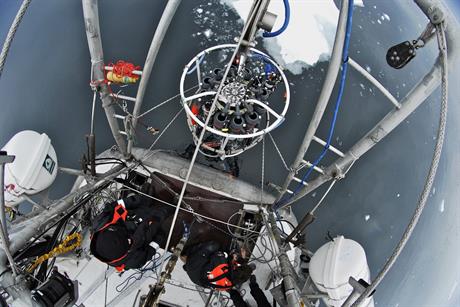The first results of the 2009-2013 Tara Oceans expedition provided the scientific community with a solid baseline describing plankton variety and interactions in tropical and temperate ocean regions. Now, two research studies — one led by Lucie Zinger and Chris Bowler, at the ENS - PSL and CNRS in Paris; the other by Shinichi Sunagawa, at the ETH Zürich, Switzerland — together with Tara Oceans consortium scientists, are taking one step further by incorporating new data from the Polar Circle circumnavigation, carried out in the Arctic Ocean in 2013. These are planetary-scale sets of sequencing and imaging data developed at Genoscope (CEA) and the Marine Biological Station in Roscoff and Villefranche/Mer (CNRS and Sorbonne Université).

Published on the 14th of November in Cell, these results show that planktonic species are distributed unevenly and may adjust differently to environmental conditions between the equator and the poles. These findings are expected to have strong ecological, environmental and economic implications, in the event of a rise in ocean temperature above a certain threshold.
Along with the recent IPCC Special Report on “the Ocean and Cryosphere in a Changing Climate” these studies provide additional insights into the potential impacts of climate change on marine biodiversity. As shown by Claudet et al. (see the One Earth perspective also published on the 14th Nov.), there is a strong need from science to develop evidence that can better inform policies to implement viable sustainability solutions, as well as operational and transformative actions that can better impact societies, from local to global scales. These are critical steps as we head to the COP25 in December and the upcoming United Nations Decade of Ocean Science for Sustainable Development.
Planktonic species diversity gradient and activity revealed from the equator to the poles
The ocean is often said to be the only continuous ecosystem on the planet, and a foundation for Earth’s health. The astronomical number of viruses, microbes, and small animals drifting with marine currents — collectively called « plankton » — play a crucial role: they form the basis of the marine food chain, capture a large fraction of atmospheric carbon dioxide and release oxygen through photosynthesis.
A first group, led by Lucie Zinger, an ENS - PSL assistant professor, and Chris Bowler, a CNRS research director in Paris (France), analyzed the data collected from 189 sampling stations worldwide during the Tara Oceans expedition. Their objective was to identify the drivers of the diversity of all major planktonic groups in order to map their distributions at global scale and get insights into how they could respond to climate change. The scientists combined new and already published genetic data to identify the species, and state-of-the-art imaging analysis to evaluate the quantity of each species present in the samples. “Our results clearly show that the planktonic diversity is more important around the equator, and decreases towards the poles”, explains Lucie Zinger. “The existence of such latitudinal diversity gradients is well established for most terrestrial organisms and was described by Alexander von Humboldt 200 years ago. It’s an interesting coincidence that we can prove its validity for most planktonic groups in the global ocean, from giant viruses to small metazoans, on the 250th anniversary of his birth.”
In parallel, the group led by Shinichi Sunagawa, an assistant professor of Microbiome Research at ETH-Zürich (Switzerland), worked on the massive Tara Oceans DNA and RNA sequencing data sets that were generated by CEA-Genoscope, and are publicly released today with the papers, to establish a new global catalog of 47 million ocean microbial genes that now extends to the poles.
The team used these data to analyze the activity of microbial communities by measuring the products of gene transcription – called the metatranscriptome. In other words, they analyzed which genes are actively being expressed in microbial genomes to understand the capacity of microbes to adapt to changing environmental conditions. “This analysis allowed us to study not only what ocean microbes are capable of doing, but also what they actually do at a global scale. We found the mechanisms influencing the community transcriptomes of bacteria and archaeal communities, and hence their adaptation to new environmental conditions, to be very different around the equator and at the poles”, says Shinichi Sunagawa.
Temperature, key parameter of microbial distribution and activity in the ocean

The diversity gradient and functions observed in bacterial species do not change regularly with increasing latitudes. Microbial activity and diversity remain stable between the equator and 40° latitude (north or south), then they change rapidly, in steps, to approximately 60° latitude (north or south), where a new stable state begins.
These two ecological boundaries (one north of the equator, the other one south) match physical and chemical changes in surface waters, mainly a steep drop in temperature. The composition and quantity of the microbial populations on both sides of this boundary vary greatly. The new maps of plankton diversity created by the team led by Lucie Zinger show that similar boundaries exist for all planktonic species, from bacteria, archaea, protists and zooplankton to most viruses. Here too, temperature appears to be the main factor explaining these patterns, with resource availability coming second.
Towards a “tropicalization” of temperate and polar ocean regions
The paramount influence of temperature on the distribution of planktonic species raises obvious questions in the current context of climate change. Based on the most recent and accurate IPCC models, Lucie Zinger’s team predicted how plankton biodiversity could evolve in collaboration with Laurent Bopp, also at ENS - PSL. Although these results need to be refined and validated, they clearly show that higher oceanic temperatures are likely to cause a “tropicalization” of the temperate and polar oceanic regions, with higher water temperatures and an increased diversity of planktonic species.
Temperate and polar waters are currently very important for several environmental and economic reasons: they play a crucial role in capturing atmospheric carbon and storing it in the ocean; they are very active fishing areas, and large regions of these waters are protected to provide shelter for endangered species. However, the most important changes in diversity predicted by Lucie Zinger’s team are expected to occur in these areas, which is likely to alter the associated ecosystems and have serious consequences worldwide.
From warm to polar waters, what response mechanisms are involved?
No current model can accurately predict how ocean ecosystems will adapt to climate change. However, the research conducted by Shinichi Sunagawa and his team provides us with clues about the mechanisms involved, at least with respect to planktonic bacteria and archaea. Generally, microbial communities can adapt to environmental changes in two different ways: first, by adapting their metabolism, and hence their gene expression patterns to make the most of the new conditions. Secondly, they can replace their less adapted member species by better adapted ones. Studying the transcriptomes allowed the scientists to disentangle which adaptive mechanism prevails in which environment.
Microbial populations in warmer waters — between 40° N and 40° S — are more diverse and benefit from a large pool of genes that can be switched on or off in case new characteristics are needed to adapt. As a result, species can adapt their metabolism and continue to thrive. In polar waters, however, the variety of microbial species and genes is much more reduced and plankton communities adapt through species turnover rather than differential gene expression This suggests that the ecological niche of these species is narrower, and some of them might not be able to adapt their metabolism in response to ocean warming. Subsequently, they could potentially disappear and be replaced with new species from warmer waters.
Thus, the warmer and colder waters appear as two ecosystems with distinct adaptive mechanisms for their microbial populations. This result points towards potentially very different responses to climate change in different regions of our oceans.
Key points
● The diversity of planktonic species varies across latitudes
● Projected future changes in plankton diversity may have significant biogeochemical and economic impacts
● The adaptation mechanisms of planktonic microbial communities to respond to climate change are different in warm and cold waters
● Planktonic microbes in polar waters are more specifically adapted to their ecological niche than those in warm waters. As a result, they may be less capable of adapting to future climate change.